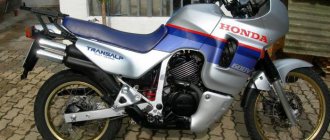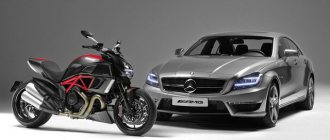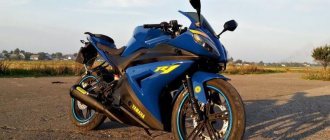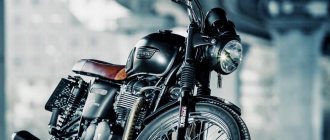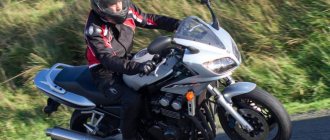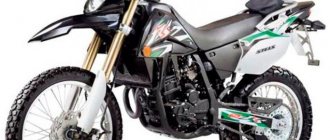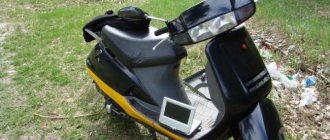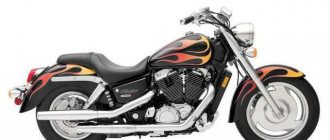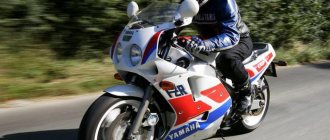Fight for the championship
The model was produced from 1996 to 2007. Honda created it in contrast to the creation of one of its main competitors. Before the appearance of the Drozd, the Kawasaki Ninja ZX-11 was recognized as the fastest among production motorcycles. The ambitious plans of the developers involved creating a bike that would surpass the Ninja in speed.
This dream has come true. “Black Bird” could really rush along the highway at a speed of almost 290 km/h. However, in 1999, this record was broken by another Japanese - the legendary Hayabusa. Its maximum speed was 312 km/h. Later, a new hero appeared, displacing Hayabusa. In 2005, it was surpassed by the Kawasaki ZZR 1400, which still holds the championship today. But at present, “Drozd” is a motorcycle that is still included in the list of the fastest.
Competition with Kawasaki
Since 1990, the fastest sports tourer has been the Kawasaki ZZR1100 (for America ZX-11 Ninja), its top speed is 282 km/h.
To bypass Kawasaki, Honda created a competitor in 1996 - the CBR 1100 XX with the Super Blackbird prefix, which is associated with the supersonic aircraft - the Blackbird. It was a successful marketing move.
The Honda blackbird came out lighter, more aerodynamically designed and stronger, it had 153 hp. versus 147 hp ZX-11 Ninja, but it beat Kawasaki's record by only 8 km/h.
Pages of history
The Honda CBR1100XX Blackbird model began production in 1996. She immediately won many fans. In 1998, the company carried out a small modernization by changing the thermostat housing. A year later, the Drozd motorcycle underwent its first major update. Instead of carburetors, the model received PGM-FI electronic fuel injection. The inertial charging system made it possible to increase the maximum engine power to 164 hp. With.
The new reconfigured combined brake system is responsible for perfect distribution of forces between the rear and front circuits. The tank capacity has also increased - from 22 to 24 liters. The radiator became more massive, and instead of seven clutch discs, the bike received 9. Drozd motorcycles of this and subsequent years of production have a power of 164 hp. With.
In 2001, the designers equipped the bike with an electronic dashboard. The shape of the windshield has been modernized, which ensures comfort at high speeds. The next year, 2002, was marked by a reconfiguration of the injection system, which began to comply with new environmental emission standards. From now on, the Honda Drozd motorcycle began to produce 152 hp. With. power at 119 Nm of torque. Soon the company began to gradually phase out production. In 2003, it stopped being supplied to the US markets, and in 2007, production was completely discontinued.
The most explosive weapon Honda CBR 1100 XX
In California, a test drive of CBR1100XX motorcycles took place on a 12 km long track. The reason for it was obvious: to prove that the new model of the CBR1100XX motorcycle was faster than the KawasakiZX-11, which was considered the fastest motorcycle at that time.
The CBR1100XX features the user-friendly instrument panel first introduced on the VFR750F. The speedometer is visible in any driving position, which is very important for the racer. The tachometer is located in the lower right corner of the panel. The model is also equipped with a clock and fuel indicator.
The motorcycle engine has a power of 149 horsepower at 9500 rpm. The top-notch engine and fairing did the trick, and the CBR1100XX outperformed its rival, the KawasakiZX-11. In this test drive, the XX was driven by driver Jason Black. While riding, the tachometer showed 10,950 rpm, the motorcycle was moving in sixth gear at a speed of 178.5 km/h.
This record did not come as a surprise to anyone, because the developers of the new motorcycle model talked about it in advance, but being careful, they did not give a 100% guarantee. I just had to believe the rumors.
Looking back at the latest Honda models, it’s easy to see the basic principles of the company’s motorcycle production: all models are refined and versatile, with decent assembly and configuration. The handling of a motorcycle is more important than its power. The CBR600, CBR1000 and VFR750 are proof of this, as is the CBR 1100 XX, but this latest model is suddenly the fastest there is. Apparently, Honda no longer wants to take second place on the podium.
At the front of the motorcycle there is a 43 mm “HMAS” telescopic fork with a travel of 120 mm. Two floating rotors (310 x 5 mm) on the front wheel (3.50 x 17 inches) and 3 Nissin piston calipers. The rotor is made of stainless steel with 6 spokes, and on Honda models with a large wheel diameter there are 10-12 spokes.
Here's what the press writes about the new Honda model: “Beautiful appearance has never been the main goal of production. Pure aerodynamics come first.” The fairings are the by-product of careful and extensive wind tunnel testing; the model has few sharp corners in its design; thanks to the air ducts on the front wheel, a low-pressure zone is created on its outer edge, this helps control the air flow around the front wheels; The front turn signals are integrated into the mirrors, as on the NR750, eliminating air resistance. The CBR1100XX has a lower drag coefficient than the NSR250.
The most important element in the design is the inclined front fairing. Bulky conventional headlights did not fit into the XX model with its radically pointed nose. As a result, combination headlights were developed that shine both high and low beam at the same time.
It's no secret that the most important thing in a motorcycle is its engine. The CBR1100XX motorcycle engine, with a power of 149 horsepower, replaced the engine with 136.7 horsepower.
The brake is located on a bracket behind the right fork slider. On the previous model with LBS brake, the front and rear brakes were used simultaneously. And in the CBR1100XX model, when you press the brake, first the left piston is activated, and then the right one. The result is smoother braking.
When journalists asked one of the main Japanese designers why the CBR1100XX did not have an inertial inflation system, the answer was short: “XX has 164 hp. With. [Japanese standard] and very fast. It doesn’t need inertial inflation.” Such a system would make the bike even faster, but it is quite difficult to achieve. And besides, without inflating, this motorcycle reaches a speed of almost 290 km per hour, which is very impressive.
The CBR1000 fairing looks very good. The black frames, subframe and engine blend with the thin aluminum components, oil lines and wire braid. And this sophistication can be seen throughout the motorcycle. Every aluminum body fastener, steering head and exhaust pipe are neatly cut out.
The very idea of a model is built not only from its individual details. To be called the greatest motorcycle, it must be comfortable and easy to ride. The creators also put a lot of effort into this. The panel and footrests are made to a high standard. The motorcycle is easy to control. However, the instrument cluster is not so simple; the speedometer occupies a dominant position on the panel, which suggests that the developers wanted to draw the driver’s attention to the speed capabilities of the model.
The engine in the previous model of the CBR1000 motorcycle had a displacement of 998cc, this model has a 1137cc engine and weighs almost 10 kg more. Honda used a rubber damper and floating clutch to dampen internal engine noise.
The XX is by no means a small motorcycle. He weighs 557 pounds. However, the large mass of the motorcycle is not felt when driving. This is achieved not only by mass centralization, but also by placing the fairing and windshield closer to the driver than usual. Unlike many bulky motorcycles, this motorcycle has a narrow fairing and a wide, flat windshield that create the feeling of riding a small motorcycle.
Despite the large engine, the bike does not make a loud roar. Another advantage of the model is the six-speed gearbox. The developers planned to use a cable-driven clutch, but the hydraulic unit worked surprisingly well. Even in adverse highway conditions, the traction ensures a smooth ride. Our test drive was hampered by bad weather and the bike was moving in second gear. But under ideal track conditions, the CBR1100XX will beat its rivals in 10 seconds at a speed of 212 km/h.
Riding a liter motorcycle in the city is comparable to riding a tank, but the Honda surprised us. It doesn't take much effort to control a motorcycle on a busy road. Maneuvering at low speed is quite easy. Folding side mirrors are what you need for those who drive in places with limited space.
The latest Honda model's wheels are quite large at 58.7 inches, which is four-tenths of an inch shorter and heavier than those on the CBR1000. The black frames pair beautifully with the black sculpted body. Sixty percent of exported models have Bridgestone BT57s (as pictured), the rest are Dunlop's D205.
So, the test drive showed that the motorcycle is very fast and also quite smooth. Honda balancer shafts do their job by preventing unwanted vibrations while driving.
The power increases with the speed, as if the motorcycle were equipped with an air duct. The engine has power over 6000 rpm, but due to the large diameter of the carburetor diffuser (42mm), there is not enough air speed to climb the mountain at low speeds. However, as the speed increases, the speed also increases, and then the driver better grab the steering wheel firmly. Peak power is achieved at 9,750 rpm, but on the test drive the XX motorcycle withstood 10,950 rpm!
Is the SBR1100XX a nimble motorcycle? Several tests have answered this question. Due to the non-adjustable front end, the suspension is overdamped. Low compression and rebound rates cause the bike to wobble over bumpy terrain. This causes inconvenience. This could have been avoided with a fully adjustable fork, and the fact that Honda didn't include this feature is inexcusable.
Dual mufflers are necessary to keep exhaust noise within acceptable limits. The rear wheel (5.5 x 17 inches) has a 4.7-inch "Pro-Link" suspension with adjustable spring preload and rebound damping. The two X (XX) emblem is a decorative element of the motorcycle.
The rigidity of the frame counteracts the rigidity of the suspension. Even with the suspension shortcomings, the bike handles twisty terrain well at high speeds. Moving the motorcycle from top to bottom requires little steering effort, as opposed to leaning from one side to the other. The two-stroke engine of the CBR motorcycle promotes rapid movement in space. The motorcycle's braking system copes well with critical situations when the driver has to suddenly reduce speed. In this, this motorcycle model is superior to previous ones.
The fairing outlets direct air into the oil cooler and radiator. Separating panels prevent hot air from mixing with cold air flowing through the openings in the upper fairing to the 9.5-liter vent box.
Unfortunately, the additional brake lines, retarders and servo mechanisms mask one drawback characteristic of Honda models - the feeling of a “soft lever”. But six pistons on three rotors is definitely considered a plus. Some test drivers use the rear brake quite hard, not thinking it would cause rearing, but the retarders do a great job of preventing this from happening. Each driver will evaluate a motorcycle's braking system differently. This is a review of the Honda model that brought us the fastest motorcycle ever created. The CBR1100XX has set an even higher standard in the sportsbike market, combining comfort and handling in a fast and refined package.
Honda combines comfort and handling in a fast and refined package.
Make no mistake, the CBR1100XX is not just a CBR1000 with an upgraded fairing. This is a new Honda project. Experts have created a leader among other motorcycles. Instead of using the engine from the first CBR models, Honda developed a new design with a 1137cc engine and cylinder block configuration. The cylinder block is angled forward approximately 22 degrees more than on the old CBR, allowing it to accommodate the largest carburetor in existence (Keihin CV, 42mm) on a 4-barrel motorcycle. (The previous CBR model had a 38mm carburetor). The camshafts are driven by a side cam chain, which reduces the distance between the cylinders and gives room for the engine. The placement of the cam gear on the right side (compared to the old model, where it was located in the center) allows for a narrower and lighter cylinder block. In addition, the steel cylinder liner has no protrusions on the surface, so the entire upper aluminum body of the motorcycle is cast as one piece, making it more economical and easier to process. The cylinder block is now 408.5 mm wide. Holes and stroke parts are 79 x 58mm compared to 77 x 53.6mm on the old CBR model.
Here is a double shaft balancing system. The first balancer moves from the crankshaft in the opposite direction to the movement. Another balancer is located above and below the crankshaft, moving opposite to the direction of the first balancer. Honda claims that the combination of these two balancer shafts eliminates most engine vibrations.
The cylinder head is similar to those installed on the 600 and 900 models. It is based on a valve actuation system using a piston. The valve angle is now 30 degrees (compared to 32 degrees on the 600 and 900 models), allowing for a flatter, more compact combustion chamber and more efficient flame movement. The valve dimensions are 32mm for intake and 27mm for exhaust. Honda's designers wanted to make the XX as streamlined as it was powerful, and by eliminating the engine mounts, they incorporated frame powertrain. The strengthened frame added weight to the motorcycle. Prior to the Model XX, other motorcycles used only a single balancer, but Honda installed a dual balancer system designed to eliminate high-frequency engine vibration. The computer-controlled 3D ignition system combines with the throttle position sensor on the carburetors and monitors to regulate throttle angle and engine speed. To cool such a powerful unit, Honda created a new high-capacity aluminum radiator. To dampen excess noise, the clutches are lined with a thick rubber pad and have rubber inserts around the mounting bolts. The spring-loaded front gear has six speeds and effectively reduces excess driveline play and resonating noise produced by the main gear.
The newly developed frame consists of three layers and has a box-shaped section, it is made of aluminum and has dimensions of 40 x 90 mm. Unlike the frame on previous models, this one is more durable. Honda specialists have created a “tuned” frame with an optimal ratio of torsional and lateral stiffness.
Appearance
If you take a quick look at the Drozd, the motorcycle will seem like a typical representative of the sports class. However, the manufacturer positions it as a “sport-tourist” model. You can not only drive it on the highway, but also go on a long journey. A comfortable pilot position, excellent wind protection, and the ability to install panniers - all this is conducive to long trips. Many Drozd owners gravitate more towards single races. Traveling in a convoy for a long time on such a fast unit can be difficult.
Regarding comfort
Drozd Honda is not as comfortable as a road bike. But unlike a sportbike, it has a more upright seating position - the tank sticks out a lot and when you lean towards the steering wheel, you immediately rest against the tank, while your back and arms are unloaded, which allows you to travel long distances without much strain. The saddle is semi-soft, one-piece for the driver and passenger.
On the Super Blackbird you can hang all sorts of cases, bags and everything you need on a long journey.
The target audience
“Drozd” is a motorcycle that fits perfectly into the pace of a large modern city. It was developed for those who like to drive along deserted night streets. Even long-term riding at top speeds is quite acceptable for this bike. The manufacturer honestly warns about the frisky character of the Drozd; even its name refers us to flights and conquered peaks. If this is the type of riding you like, this might be your option. It will also appeal to those who not only have to drive along the highway, but also maneuver around the city, avoiding traffic jams, braking and again rushing forward at traffic lights, driving along narrow curved streets.
At the same time, we should not forget the following: like most large cars, Drozd will require considerable skill. He is heavy, but agile. You can't call him clumsy. With good handling and stability, which manifests itself even on turns, the motorcycle requires a certain level of skill from the pilot. Any vehicle with an engine of this size rarely becomes the first, according to experienced bikers, you need to grow to the “liter”. “Drozd” is more often chosen by those who have already driven 600 and 800 cars.
Features of behavior
As one would expect from such a device, it quickly picks up speed and shows considerable stability. At the start, the blackbird easily outperforms not only most sports bikes, but also many cars of the same class. It’s not for nothing that he was considered the fastest in the world for so long. Many owners consider the operation of the brakes to be an important point. It has 2 discs in front and one in the back. A heavy bike slows down quite quickly. If desired, of course, you can install ABS on this motorcycle.
Technical features
"Drozd" - a motorcycle, the characteristics of which are given in the table, has a number of features.
| Engine | In-line, 4 cylinders |
| Frame | Spatial, aluminum |
| Engine volume (working), cm3 | 1137 |
| Cooling | Liquid |
| Base, mm | 1490 |
| By saddle, mm | 809 |
| Curb weight, kg | 254 |
| Acceleration to hundreds, sec. | 2,8 |
In appearance, the motorcycle seems like a heavy truck. In fact, its dry weight is 223 kg. Some people start tuning after purchase, trying to reduce weight. By the way, this idea apparently came to the manufacturer himself. After all, on the basis of “Drozd”, a naked bike was produced for quite a long time, differing only in its skin (and weight, respectively).
Another noteworthy aspect is fuel consumption. It is quite small for a motorcycle in this class. Get ready for the Drozd to consume an average of 5.9 liters on the highway. per hundred. Of course, this figure largely depends on the speed at which you will move. When cruising at 180 km/h, the motorcycle’s appetite will increase to 7-8 liters.
Test drive HondaCBR 1100 XX, HondaVFR 800 FI
These motorcycles belong to the same class, but occupy two adjacent niches. The joint test drive was not carried out by chance. His goal was to identify common features and differences between large- and medium-sized sports tourists, as well as to determine the habitat of each, answering, if possible, the question: “Why are they considered legendary?”
Honda VFR800Fi 2001
Honda CBR1100XX 2003
Acquaintance.
The shapes of the fairings of both motorcycles clearly hint that they were created in the same design studio. The Drozd's appearance is dictated by high demands on aerodynamics and stability at high speeds. It has a more elongated silhouette than its brother and a characteristic “beak” of the front fairing, for which this motorcycle seems to have received its bird nickname. But that's not true! “Blackbird” because “Black Bird” is “thrush” in English. “Vyfer,” on the contrary, looks noticeably narrower, shorter, more aggressive and more compact, evoking thoughts that it will be much more compliant in turns – this is the first and main difference. In general, the appearance of the motorcycles is quite fresh, despite their production years (2001 and 2003).
Ergonomics and fit.
Don't forget that both bikes are from Honda. Therefore, traditionally for this manufacturer, the moral and physical comfort of the rider is above all else. But it's time to tell you more about motorcycles. Remote controls on the steering wheels, hydraulic machines, brake and clutch levers, handles, dashboard design - everything is made of very high quality, convenient and harmonious, and also hints at family ties between the bikes. The Vyfer boasts an almost upright riding position that can easily be turned into a sporty position by simply moving back. The footrests are located relatively low - it is comfortable for the feet, and even a beginner can scratch them on the asphalt. On the Drozd, the seating position is more sporty, with a significant forward tilt of the body and a greater bend in the knees. When riding at low speeds, the rider's hands are constantly loaded, which makes using this bike in the city less comfortable. The seats of both motorcycles are of the same type and are able to peacefully coexist with the driver’s “fifth point” for many hundreds of kilometers. The passenger seat is more comfortable on the “edge” - there is less bend in the knees due to lower-mounted footrests. Plus, the passenger doesn't have to bend over too much to rest their hands on the tank (I hope your passengers know that's how they're supposed to sit?). The driver’s moral comfort is also facilitated by standard immobilizers installed on both bikes. But it turned out to be easier to place the heavier “thrush” on the central stand - it was placed better.
Dashboard.
On the Vyfer, next to the analogue speedometer and tachometer, there is an LCD display that provides the driver with information about the fuel level in the tank, engine and ambient temperature. It also has an odometer, two tripmeters and a clock. The warning lamps are standard: high beam, turn signal indicators, neutral indicator, oil pressure indicator and check engine lamp. Drozd has exactly the same set. True, it has analog fuel level and engine temperature sensors, and the clock is located in a separate window. The readability of both devices is quite good. But I would like to give the Vyfer a “plus” for its more modern cockpit design.
Engine, clutch and gearbox.
The Drozd has an injection inline four with a volume of 1137 cm³. It feels like the distribution curves of power and torque are quite linear - there are no dips or pick-ups, but only smooth and powerful acceleration, which begins to weaken only when the speedometer needle passes the 200 km/h mark. The engine is very elastic - when you open the gas in sixth gear and a speed of 60 km/h, the motorcycle accelerates smoothly, without jerking or vibration. The first gear is moderately long, the cut-off occurs only at 120 km/h.
The Vyfera is equipped with a longitudinal injection “V”-shaped four with a volume of 782 cm³ and a cylinder camber of 90°. The engine has sporting roots, as evidenced by the gear drive of the camshafts, which was used mainly in racing vehicles. It is this drive, coupled with the characteristic “voice” of the intake resonator, that adds a howling note that is annoying at city speeds to the unique sound of its engine. This type of engine design is much narrower than an in-line one, and the radiators are located on the sides - here they are better protected from dust and dirt. This engine is already less elastic - it was able to perform the same trick as the Drozd only from 70 km/h. But on the other hand, it reacts more sensitively to the throttle and spins up faster, showing a sporty character (especially when the tachometer needle passes the 9000 rpm mark). In terms of acceleration dynamics, which begin to fade after 180 km/h, it is inferior to its brother - this is reflected in the significant difference in power and power supply. First gear ends at 100 km/h. The power and torque curves are perhaps even more similar than on the Drozd. Engine braking on the Vyfera is more intense. Both engines boast a “strong” common feature – excellent low-end traction. If you smoothly release the clutch, you can start moving even from idle.
I can say one thing about the gearbox – it’s Honda! The strokes of the paws are quite short, the mechanisms work very clearly and quietly, neutral is easy to find. On the Drozd, I was a little puzzled by the placement of the paw itself - shifting up is not very convenient, and when folding the side stand, you can accidentally put it in first gear. By the way, the stands of both bikes are equipped with sensors: if you fold it back while the engine is running and the gear is engaged, the engine will stall. The clutch on both the Vyfer and the Drozd is hydraulic – it has some “wobbiness” inherent in it. Moreover, on the latter it is tighter - when moving around the city for a long time, the left hand begins to ache out of habit.
Suspensions and frame.
Both motorcycles have diagonal aluminum frames, conventional telescopic forks and monoshock absorbers, adjustable for spring preload and rebound. This is where the similarities end. “Vyfer” boasts a fork adjustment for preloading the springs and a cantilever pendulum, so the rear wheel can be removed in a matter of minutes, and the chain tension is adjusted by an eccentric. Thanks to the cantilever wheel mount, the designers placed the muffler to the left than with the traditional two-arm design, which had a positive effect on the width of the bike - this is true, by the way. On the Drozda the fork is not adjustable - this is a minus, but given its good energy consumption and adequate factory settings, it is insignificant. In general, the suspensions of both bikes are very successful and do not cause any complaints, and the moderately rigid frames guarantee good feedback.
Brakes.
The calipers on both bikes are the same - two floating 3-piston Nissin calipers at the front, paired with floating discs, and one, also 3-piston, at the rear. Also, the “Vyfer” and “Drozd” have the “proprietary” CBS combined braking system. The principle of its operation is that when you press the rear brake pedal, part of the pistons of the front calipers is also activated, and when you press the front lever, one piston of the rear one is activated. True, there is a small nuance here. Brake fluid enters the rear line only when the bypass valve located on the left fork is open. And it opens only with sufficiently dynamic braking. This means that if you press the front brake “statically,” there will be no force on the rear brake. In fact, this system practically eliminates dive when braking; instead, the motorcycles seem to squat.
The efficiency and information content of the brakes is much better in the Vyfer - less weight plays a role in this. The moment of “grabbing” occurs much earlier than in the “Drozd”, the brake lever of which sags quite strongly. Both motorcycles are characterized by some “softness” on the lever, due to the large length of the brake hoses, but, again, on the Drozd the lever is “softer”. This reduces the information content of the system to almost nothing. For this, we can recommend installing rigid brake hoses.
Light.
Great on both bikes. The Vyfera has two double-filament halogen lamps. Both the near and far lights are on. The light beam is well collected. On the Drozd, one lamp is lit on the low beam, and when the high beam is turned on, a second one is connected, illuminating an additional section of the road.
In move.
In the city, “Vyfer” wins unconditionally. It is much narrower than its counterpart, has a shorter wheelbase and a smaller turning radius. It makes it easier to squeeze through traffic jams, and the lighter weight and almost upright riding position reduce rider fatigue. Its clutch and gas are softer, and the location of the gearbox foot, as I said above, is somewhat more convenient. The visibility in the mirrors is better - they can see everything that is needed and not needed. To be honest, I have never seen better visibility anywhere. They are located higher and slightly wider than that of their “brother”. It seems that the city is one of his elements. The controllability of the “Vyfer” deserves the highest praise. It goes into turns and bends almost with the power of thought, while the Drozd needs to be “dragged” there with the help of strong counter-steering and body tilt - such intransigence even left me a little confused at first. As it turned out later, the tires worn out in the center were partly to blame for this.
But on the track everything changes. If not diametrically, then, in any case, quite strongly. “Drozd”, due to its larger base, “stands” better on the trajectory, while “Vyfer” is more susceptible to side winds and the influence of turbulent flows from oncoming or overtaken cars. The more sporty Drozd seating position takes its revenge here - the rider is somewhat more comfortable lying on the tank. If you hide behind the windshield on the Vyfer, you immediately feel the disadvantage - only the sky is visible in the high-mounted mirrors. They can be reconfigured, but then, when you straighten up, you can only see the asphalt under the motorcycle. In addition, at speeds of about 230-240 km/h they fold spontaneously, thereby reducing drag (and why are they at that speed?). Joke. Wind protection is better on the Drozd and allows you not to bend down up to 180 km/h, while on the Vyfer you want to lie down already at 160 km/h. Another drawback was discovered - after 150 km/h, the windshield, part of the front fairing and mirrors of the Drozd begin to vibrate with a very large amplitude. To be honest, I don’t know whether this is a feature of the model, or is unique to the sample being tested. On Vyfer, a similar effect is not observed at any speed.
Overtaking on the highway, of course, is better for the Drozd. In rare cases, it was necessary to switch from sixth to fifth gear, but on the Vyfera, in order to obtain equally dynamic acceleration, you need to drop two gears at once.
The Vyfera's fuel consumption is within the range of 5.1-5.3 l/100 km at a speed of 120-130 km/h. on the highway, when driving without a passenger. In the city, these figures rise to 7, and if you drive in the “they won’t catch us” mode, then up to 10 liters per “hundred”. The Drozd motor is more voracious.
Conclusions.
“Drozd” is a motorcycle for high-speed touring on good roads. Or, as my friend called it, “a long-range sports tourer.” It stands up well on the trail and has decent wind protection. The torquey and responsive engine has many advantages. It almost does not vibrate, has close to linear distribution curves of power and torque, and this is a good help when driving in the rain or in mountain serpentine conditions, when there is a risk of the rear wheel slipping with the wrong movement of the right hand. Suspension, brakes and handling are not the strong points of this motorcycle. Driving it in the city, of course, will not be perceived as an annoying necessity, but, frankly speaking, it will bring little pleasure. Maneuvering at low speed in dense city traffic is not his thing. But, believe me, it won’t disappoint you on the highway; it’s not without reason that many long-distance trips have been and are being made on this model.
“Vyfer” is equally good for both the city and the highway. Like Drozd, it loves good quality asphalt, but is more likely to be a “mid-range sports tourer.” For its year of manufacture and class, it is quite high-tech - injectors, hydraulic clutch, combined braking system, adjustable fork, gear drive of camshafts. And because of the rear wheel cantilever mounting and the large LCD display on the dashboard, it still looks fresh. Its strengths are: good handling, compactness and a successful engine. Perhaps it was not for nothing that American marketers called this motorcycle “Interceptor”. But, despite the formidable nickname, it will forgive many mistakes of a beginner, and at the request of an experienced rider it can be both a “sport” and a “tourist”. Due to its versatility, the Vifer is quite suitable as a “motorcycle for every day.” For the weekend in Crimea? Easily! “Shoot” with your sport biker friends around the city at night? Easily! Flash a traffic jam during rush hour? And this is possible.
Explaining the legendary nature of these two motorcycles is difficult and simple at the same time. There are bikes that are superior to them in a variety of characteristics. They are either faster, or more beautiful, or more comfortable, or... That's it, “or”. And these two sports-touring Hondas combine many disparate and sometimes even contradictory features, which, nevertheless, live in complete harmony with each other. Therefore, the reason for the legend of these bikes lies precisely in their harmony and versatility, which are combined with a very reasonable price.
Opinion: Honda CBR1100XX owner
Alexander Slysh
“Drozd” is my first motorcycle (in adult life). Mots-dream! Fighter! Every trip is a lot of positive emotions. I don’t even want to tune anything other than installing a damper. Now, about the characteristics. Let's start with the shortcomings.
The first one is a bit heavy. Although this is a plus - it doesn’t throw you around on the road like a light sport. The second drawback is low ground clearance. Often you need to jump on or off the side. If you get too caught on the bottom, you can crush the pipe or break the plastic.
Perhaps, due to its solid appearance and impressive overall dimensions, one may get the impression that this motorcycle is not designed for city riding and overcoming traffic jams, but it was experimentally found that this is just a myth among the envious people of the “Black Bird”. Although the dimensions do not give special grace to the motorcycle, it justifies itself in many other characteristics. True, within the city limits you won’t be able to fully experience the full power of this motorcycle. But “Drozd” provokes its owner to speed! But at any speed the bike goes smoothly and smoothly, there are no sharp jerks, and it holds the road superbly, and with proper handling it turns quite easily. As a representative of the sports touring class, the bike has a very comfortable fit, allowing you to ride with an almost flat back, without forcing yourself to press against the tank.
Brake system – good! The hand lever applies 2/3 of the front and 1/3 of the rear brake. Foot - on the contrary. I once tried to stand on the front wheel - almost. Why "almost"? Yes, the brakes are combined! I don’t advise you to try - the motorcycle is heavy, if it starts to skid, you may not be able to hold it. But the bike gets up on the rear wheel, although not very willingly, but it gets up.
At low speeds, on the highway, fuel consumption is more than moderate. With 10 liters you can reach up to 170-200 km. If you “fly” 200 km/h, then the consumption is a solid 10 liters. But tire pressure is the scourge of heavy vehicles. I advise you to follow the recommended 2.9 atm in both wheels exactly. Good wind protection, low motor vibrations. And it’s nice to ride with a passenger. I would like the clutch lever to be softer - the hand sometimes gets tired. On long trips I hardly get tired and I arrive at my final destination more refreshed than if I were traveling by car.
I like to drive the Drozd into the city center, leave it and step aside. Picture: a curious passer-by stops, leans towards the speedometer, straightens up, and then, doubtful, with the words: “how much?” leans over again. Yes, dear, you didn’t think so! The speedometer shows 320. Any questions? More - 340 - only the twelfth "Kava" and "Hayabusa" of the first issues. Remember, Blackbird doesn't drive, it flies low!
I also rode the Vyfer. Unfortunately, the allotted time was not as much as I wanted, so I will describe my impressions more briefly.
This is a sport-tourist - what can one take from it, although after Drozd it’s somehow uneasy, it’s too nimble. The seat is comfortable, the glass is large, there are a lot of instruments. We started it up and went. The engine sound is cool (rattling-rumbling). Reception from the very bottom to 12000 is smooth and predictable. The dynamics are very decent up to 180-200, but over long distances it will probably still be a bit difficult. At speeds “over 200” it is not very stable. The box turns on with just a light push - super! It is easier to turn in turns; after all, the weight is less than that of the Drozd, and the wheelbase is shorter. Everything is very simple and predictable. In general, it seemed to me that the motorcycle weighs lighter than stated - it turns too easily. It’s still strange: it has all the attributes of a tourist, but it handles almost like a sportbike. “Two in one,” so to speak. I didn’t try to goat - it’s not my motorcycle after all! The brakes are good. At a speed of “over 200” because of the large glass it doesn’t blow, it goes at 250, well, but somehow there was nowhere else. In general, I liked the bike: light, friendly, obedient.
Text: Sergey Kuznetsov
Photo: author
Tuning options
An irresistible desire to improve even the best sometimes visits every biker. The most common alterations that Drozd most often undergoes are the following:
- Heated grips.
- Xenon in optics.
- Modernization of the skin, “nakedization”.
- Installation of ABS.
- Removing glass.
- Painting.
- Removing the passenger seat.
Prices
If you are planning to purchase a bike of this model, most likely you will not be able to find a new one due to the fact that its production has been completely discontinued. But the secondary market is saturated with completely viable units. “Blackbird” is a motorcycle that was produced for the United States of America and European countries. Therefore, it gets to our secondary from there. The absence of rides on the roads of our Motherland will add a lot to the price, but the technical condition of the bike in this case will be better. The price also depends on the year of manufacture: the younger the motorcycle, the higher the figure. Experts say that you can buy a technically sound Drozd motorcycle, the price of which is approximately 3.5-4 thousand dollars.
